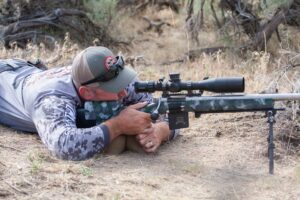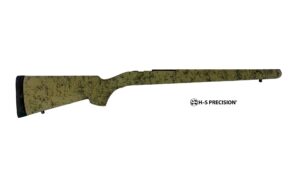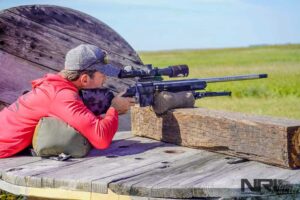As the days get longer and the sun rises earlier, getting out on the shooting range is a welcomed necessity. Although dry fire can be a significant factor in off-season practice, handling your rifle loaded with ammunition will always yield stronger results.
When you’re getting ready to load up and head to the range, don’t forget the essentials.
SAFETY GEAR
First and foremost, you will want to make sure your safety gear is packed.
Eye Protection:
Shooting glasses are an essential for anyone operating a firearm whether you are on the range or in the field. Because the chamber is so close to your face, it is best to be prepared for any particles or shrapnel that may be released which could easily cause damage to your vision.
Select contoured glasses that wrap around your eyes with a tight fit to your face. This will ensure no debris will cause visual impairment when shooting. Polarized, shatterproof lenses are also a great feature to consider investing in when you select a set of shooting glasses.
Ear Protection:
Before going hot, you’ll want your ears on. The options for ear protection are vast; from electronic, over-ear protection to disposable in-ear foam plugs, you are sure to find a solution that works best for you.
No matter which direction you go, make sure the fit is correct. Look for a padded band and adjustable ear cups when selecting over-ear muffs. Foam plugs must be rolled before inserting into the ear canal and fully expanded before shooting.
First Aid Kit
This may seem too elementary to have on a range day checklist, however it is an essential you should have in your vehicle ready to use at a moment’s notice. From simple injuries such as a deep cut or a minor headache to more major injuries that require medical attention – a first aid kit will have what you need to care for the wounds en route.
A prepared medical kit for the shooting range should include: wrap bandages, flex bandages, disposable (latex-free) gloves, trauma shears, surgical tape, combat and traditional gauze, and a tourniquet and nasopharyngeal airway tube for more serious injuries that could occur.
Chamber Flag
Another item that is great to have when you head out to the range is a chamber flag. In fact, some ranges require them. This is an inexpensive safety measure to keep in your rifle bag that will indicate the chamber is clear when you are not using the firearm.

THE NECESSITIES
The following essentials for a range day may be a no-brainer, but we better put them on here just in case.
The Firearm
A range day just wouldn’t be the same without it. All jokes aside, it’s important to have your firearm ready for the range. Make sure it is cleaned, unloaded, and packed securely for travel. If you are going to be practicing for a particular competition or hunt, be sure to prepare your dasher or other firearms you may be bringing along, as well.
Ammunition
Unless you’re planning on dry-firing, ammunition will be handy. Make sure your ammo is the correct caliber for the rifle you are using it with. You will also want to have a box or bag to collect used brass after shots have been fired.
Handheld Weather & Wind Gauge
Having a wind gauge like a Kestrel meter will be a huge advantage to your range day. Not only will this help solidify your ballistic solutions, it will also help you adapt to unpredictable weather conditions quickly.
Targets, Tape & Paint
Depending on what your range provides, you will want to pack the targets you are intending to use. Whether these are splatter targets, a DIY zeroing target, or steel – it’s best to bring it or know what’s available to you. Tape is great when you’re attaching paper targets to steel; a staple gun works great for wood or penetrable target bases.
When we go to the range, steel targets are up and just need to be painted. Bring some spray paint or whatever is acceptable at the venue to show your hits. If you are using paper targets, or something of the like, a marker or pen may work just fine.
Optics
Especially when you are shooting long range, you will want to make sure your glass is set. This is the optics on your rifle, your binoculars, and your range finder. If you have a spotter with you, having an additional scope or binos will be essential, as well.
We’ve talked about some of our favorite long range optics here. But what about binos? We prefer the rangefinder built in like the Swarovski EL 10×42 (but any quality rangefinder will suffice). Knowing the exact distance of your target will not only help in calculating your DOPE, but will also make your time practicing at the range worth the trip.
Permits
Many ranges require forms of identification, as well as firearm permits. Check with your range to find out more information.

GOOD TO HAVE
Now that you have safety gear and the necessities packed, there are a few more things to pack along for a day at the range.
Tool Kit / Cleaning Kit
Having tools on hand will make it easier if something needs adjusting on the fly. Bring a small assortment of wrenches, a screwdriver with multiple bits, cloth rags, and multi-tool. A cleaning kit is also nice to have in case anything should happen with your firearm during your range day.
Lab Radar (Chronograph)
When we are heading out to the range and zeroing in rifles, having a lab radar is nice to detect ballistic velocities. Knowing this information is critical when shooting long range. Having faster ammunition will result in a deeper target penetration and help keep you consistently accurate.
Shooting Bag & Gun Mat
Depending on the range, you may need to bring your own shooting bags and/or gun mat. A stable foundation is the key to any kind of shooting, especially as distance becomes a factor.



